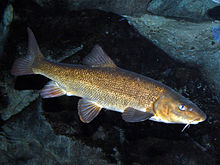Barbus
| Barbus | |
|---|---|

| |
| Barbus barbus | |

| |
| Barbus plebejus | |
| Scientific classification | |
| Domain: | Eukaryota |
| Kingdom: | Animalia |
| Phylum: | Chordata |
| Class: | Actinopterygii |
| Order: | Cypriniformes |
| Family: | Cyprinidae |
| Subfamily: | Barbinae |
| Genus: | Barbus Daudin, 1805[1][2] |
| Type species | |
Barbus is a
Description and uses
Their common names –
Barbels are often fished for food; in some locations they are of commercial significance. The roe of barbels is poisonous, however. The large Barbus barbs are also often eaten in their native range.
The smaller barbs are in some cases traded as aquarium fish. Some are quite significant, but as a whole, the genus is not yet as well represented in aquaria as the Southeast Asian Puntius.[3]
Systematics and taxonomy
Barbus has a long history as a "
Thus, Barbus is for the time being restricted to the typical barbels and barbs', and only contains fishes from
The small barbs from Africa, by contrast, are quite distinct. They might even warrant establishment of a new
Species
- , 2002 (Danube barbel)
- ) (Common barbel)
- Barbus bergi Chichkoff, 1935 (Bulgarian barbel)
- Barbus borysthenicus Dybowski, 1862
- Barbus caninus Bonaparte, 1839 (brook barbel)
- Barbus carottae (Bianco, 1998) (Yliki barbel)
- Barbus carpathicus Kotlík, Tsigenopoulos, Ráb & Berrebi, 2002 (Carpathian barbel)
- Kessler, 1877 (Terek barbel)
- Barbus cyclolepis Heckel, 1837
- Barbus cyri De Filippi, 1865 (Kura barbel)
- Barbus euboicus Stephanidis, 1950 (Evia barbel)
- Barbus haasi Mertens, 1925
- Barbus karunensis Khaefi, Esmaeili, Geiger & Eagderi, 2017
- Barbus kubanicus L. S. Berg, 1913 (Kuban barbel)
- Barbus lacertaHeckel, 1843 (lizard barbel)
- Barbus lorteti Sauvage, 1882
- Barbus macedonicus S. L. Karaman, 1928
- Barbus meridionalis A. Risso, 1827 (Mediterranean barbel)
- , 2009
- Barbus oligolepis Battalgil, 1941
- Barbus peloponnesius Valenciennes, 1842
- Barbus pergamonensis M. S. Karaman, 1971 (Anatolian barbel)
- Barbus petenyiHeckel, 1852 (Romanian barbel)
- Barbus plebejusBonaparte, 1839 (Italian barbel)
- Barbus prespensis S. L. Karaman, 1924
- Barbus rebeli Koller, 1926 (Western Balkan barbel)
- Barbus sperchiensis Stephanidis, 1950 (Sperchios barbel)
- Barbus strumicae S. L. Karaman, 1955 (Strumica barbel)
- Barbus tauricusKessler, 1877 (Crimean barbel)
- Barbus thessalusStephanidis, 1971 (Thessalian barbel)
- Barbus tyberinusBonaparte, 1839 (Horse barbel)
- Barbus waleckii Rolik, 1970 (Vistula barbel)
Fossil species
A fossil species (Barbus megacephalus Günther, 1876) is known from the Paleogene Sipang Fauna of Indonesia.,[6] but it probably should be placed in another genus.
See also
References
- ^ Skelton, P. H., Swartz, E. R., & Vreven, E. J. (2018). The identity of Barbus capensis Smith, 1841 and the generic status of southern African tetraploid cyprinids (Teleostei, Cyprinidae). European Journal of Taxonomy, (410). https://doi.org/10.5852/ejt.2018.410
- ^ Englmaier GK, Tesfaye G, Bogutskaya NG (2020) A new species of Enteromius (Actinopterygii, Cyprinidae, Smiliogastrinae) from the Awash River, Ethiopia, and the re-establishment of E. akakianus. ZooKeys 902: 107-150. https://doi.org/10.3897/zookeys.902.39606
- ISBN 0-7858-0867-1
- ^ Banister, K.E. (1973): A revision of the large Barbus (Pisces, Cyprinidae) of East and Central Africa. Studies on African Cyprinidae. Part II. Bulletin of the British Museum, 26 (1): 3-148.
- ^ Antal, L., László, B., Kotlík, P., Mozsár, A., Czeglédi, I., Oldal, M., Kemenesi, G., Jakab, F. & Nagy, S.A. (2015): Phylogenetic evidence for a new species of Barbus in the Danube River basin. Molecular Phylogenetics and Evolution, 96: 187–194.
- ^ Woodward, A.S. (1901). Catalogue of the Fossil Fishes in the British Museum (Natural History). order of the Trustees. p. 302.
barbus megacephalus.
